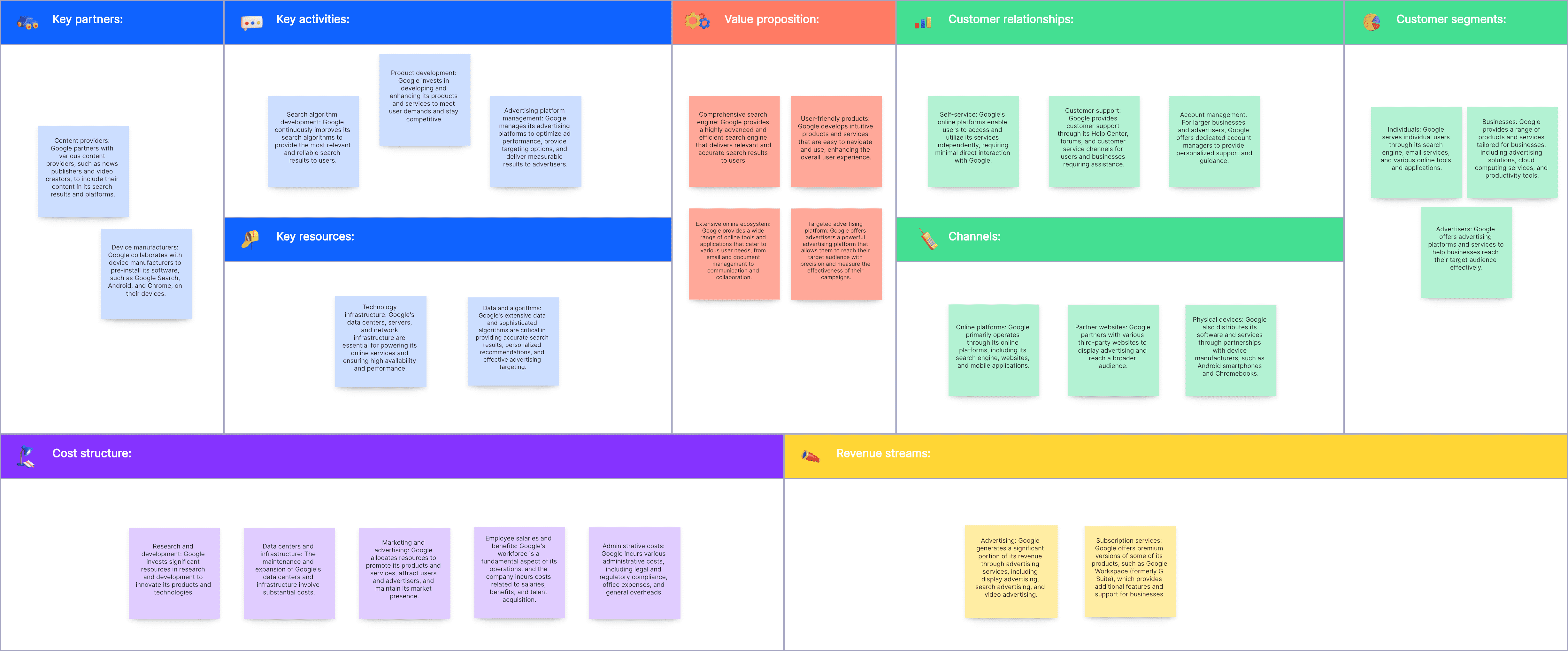Every business takes off as a startup, but not all companies get to the top and manage to stay there. Nevertheless, the Google business model canvas is proof that a multisided platform can make waves in the tech industry.
From being a website for search links, the brand now has one of the most diversified offerings in the market. Here is a look at the business model of Google, and some mind-blowing information regarding the world’s most visited website.

A Brief History of Google
The massive growth of the Internet and the ‘.com’ boom led to the birth of Google Inc. in 1998. Founded by Larry Page and Sergey Brin, the site was called ‘BackRub’, the namesake describing the search engine’s processing system. They later changed it to Google, referencing the term ‘googol’ (the number one followed by a string of 100 zeroes).
Initially, the company raised a million dollars from family, friends, and key investors Like Amazon’s Jeff Bezos. Other notable angel investors include Ram Shriram, an entrepreneur, and David Cheriton, a Stanford University professor.
The following years proved fruitful for Google, allowing the company to grow exponentially, and hiring salespeople and engineers along the way. They moved to Googleplex, which is the current headquarters located in California. In 2004, the initial public offering reached $1.66 billion. This feat transformed two founders and five other people into billionaires, with over 900 millionaire stockholders.
In 2011, the Google business model saw the site processing around three billion searches daily. The company managed to add more data centers, which housed thousands of servers to accommodate the continually growing numbers. Today, Google has offices in 50 countries, with several products and services utilized by billions of users every day.
Google Business Model Canvas
The diversity that Google offers is in line with the company’s mission of organizing the world’s information. It aims to make data universally accessible to those who need it. The brand keeps winning these days, and it’s all thanks to the highly efficient business model canvas of Google.
Here is an overview of the template brought to you by the Boardmix productivity platform. You can quickly follow the details of this canvas in one glance!

Value Propositions of Google
There’s no doubt that the branding established by Google Inc. features a solid value proposition. Firstly, advertisers can reap plenty of rewards from investing in their services. Google Ads, for example, are an effective way of reeling in prospects. In today’s market, about 80% of buyers do a simple search before purchasing. When the intent to buy is there, marketers can swoop in and introduce their brand.
For content creators, the Google Business Model Canvas serves as a platform to distribute their productions to a wider audience. Producers can explore paid media to enhance organic traffic, thereby increasing the possibility of generating big revenue. Google is also valuable for users who work, study, and play using the multidimensional platform every day.
Customer Segments of Google
Google strategically segments its market to align with its diverse value proposition. The template delineates three primary customer categories: advertisers, users, and content producers. It serves as a pivotal platform for marketers seeking to promote their products and services online effectively. Simultaneously, Google caters to daily internet users, offering them a plethora of valuable services. Content creators, including vloggers and writers, form another significant market segment, relying on Google's platforms to connect with their audiences and share their content seamlessly. This market segmentation underscores Google's ability to meet the distinct needs of a wide-ranging user base.
Key Partners of Google
It's natural for a business to interact with different partners to maintain, improve, and supplement their enterprise. Some of the firm's notable partners include suppliers, manufacturers, and distributors. The company also partners with advertisers, content creators, and users to sustain the vitality and relevance of the brand.
Key Activities of Google
The Google business model canvas is designed to create an exceptional experience for its users. It also works to avoid negative effects on the network. A major activity undertaken by the company is crawling and indexing, which are essential for search engines. Through these processes, Google can organize content and push the right information to the user requesting it.
Google also focuses on building an ecosystem that delivers the brand’s offerings like Chrome, Android, and more, seamlessly. It implements marketing tactics as well as optimizing search functionality to prevent misinformation, click-baiting, and spam.
Customer Relationships with Google
Google's business model is characterized by a self-service framework, granting customers the autonomy to navigate its platforms independently. However, for those seeking guidance or support, Google offers a robust client support system. Depending on their budget and specific needs, customers may access additional assistance, which can include having a dedicated account manager or a team to aid in setting up campaigns. This tiered approach to customer support ensures that users of all levels of expertise can maximize the value of Google's offerings while receiving the necessary assistance tailored to their requirements.
Key Resources of Google
Google as a powerful platform consists of three key resources, namely the index, algorithm, and computing power. Since the business model canvas of Google relies on a strong database, its index is an indispensable component. On the other hand, algorithms refer to the ranking of pages as they appear in search engine results.
Finally, computing power is the key to the other resources. The company banks heavily on patents and intellectual property, which involves Googlebot, a robot that automates content checking. In addition, the mobile operating system Android and a global infrastructure are also valuable resources of the brand.
Channels of Google
Effective distribution channels are a cornerstone of a successful business strategy, ensuring products and services reach customers seamlessly. Google strategically employs its proprietary search engine and the Android app store to distribute its offerings, capitalizing on its extensive ecosystem. This interconnected network enables Google to efficiently disseminate updates and product-related news across its various platforms, fostering a unified user experience. By leveraging these distribution channels, Google optimizes accessibility for its diverse range of products and services, solidifying its position as a digital industry leader.
Cost Structure of Google
Being a prominent tech company, Google maintains a substantial commitment to research and development (R&D). This strategic investment fuels ongoing improvements in its operations and fuels the creation of innovative products and software solutions. Additionally, Google incurs significant expenditures in its infrastructure, particularly in maintaining and expanding its vast network of data centers, each housing thousands of servers. These data centers are crucial to the company's ability to deliver its services reliably and efficiently. Alongside R&D and infrastructure costs, Google also allocates resources to general administration, operations, and traffic acquisition costs (TAC), reflecting its dedication to sustaining its position as a global technology leader.
Revenue Streams of Google
Google's business model flourishes due to its multitude of revenue streams. Primarily, the company generates significant income from online advertising, utilizing models such as pay-per-click, display network, and cost-per-impression. Beyond advertising, Google also derives revenue from subscription-based services, including Google Cloud, and the sale of hardware devices like Chromecast. This diversified approach not only ensures financial stability but also enables Google to meet a broad spectrum of consumer needs, solidifying its position as a prominent leader in the digital industry.
How Does Google Make Money?
Google's revenue generation, as outlined in its business model canvas, hinges on several key streams. Foremost among them are YouTube ads and Google Ads, constituting primary income sources. Notably, sponsored posts that appear in search results contribute significantly to Google's earnings, employing a cost-per-click (CPC) model. Under this arrangement, advertisers pay Google when users click on their links or engage in other specified actions.
Furthermore, Google generates income by collaborating with brands that choose cost-per-impression (CPM) advertising, compensating for ad placements based on the number of times the ad is viewed. This varied revenue portfolio, underpinned by the extensive reach of Google's platforms, exemplifies the company's multifaceted strategy for monetization, enabling it to prosper in the continuously evolving digital terrain.
The business model of Google goes beyond ads to generate income as well. It offers ad-free streaming via a YouTube Premium subscription. Google Cloud, a cloud computing suite, runs a separate infrastructure and is presented to companies that want to manage their data successfully. Google also sells devices like a smartphone (Google Pixel) and a smart home appliance called Google Nest.
Key Takeaways
The Google business model canvas operates with a keen understanding of the multifaceted nature of its platforms. It caters to diverse customer segments by making strategic investments and optimizing key resources, thereby enhancing the accessibility of its offerings. The company actively engages in ventures and partnerships within the tech industry, employing a versatile range of strategies to achieve its objectives.
For those seeking inspiration from Google's remarkable growth and development, the Boardmix platform offers a ready-made template for Google's business model. This template serves as a valuable starting point to create a customized canvas tailored to your own company's needs. Whether you're embarking on a new venture or are already well-versed in your market, this tool provides a wealth of advantages to help streamline your business processes and drive success.
By delving into the intricacies of Google's business model, you can gain valuable insights and adapt strategies that align with your unique goals and market dynamics, ultimately contributing to your company's growth and prosperity.
References:
https://www.marketing91.com/business-model-of-google/
https://www.linkedin.com/pulse/evolution-google-business-model-gennaro-cuofano/
https://businessmodelanalyst.com/google-business-model/#How_Google_makes_money
https://docs.google.com/drawings/d/102mOZQmMxs0CslmNsPZ5KCNQwAIh9rh4baYgT0VWNAA/edit
https://www.garyfox.co/google-business-model-explained/
https://pestleanalysis.com/google-business-model/#Google%E2%80%99s_Business_Model_Final_Word
https://www.denis-oakley.com/google-business-model-explained/
https://www.thevalueengineers.nl/googles-business-models/
https://medium.com/business-models-magazine/google-business-model-canvas-8b58120de2e7








